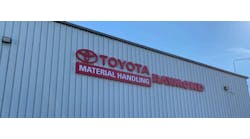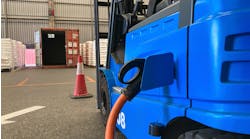By Nasser Kutkut, Ph.D.
Fast charging of industrial batteries is poised to become a mainstream charging technology due to the operational savings and the increased productivity and safety that this technology offers. Users are realizing the benefits of fast charging as fast-charge systems are already buzzing at manufacturing plants and distribution centers around the United States.
Fast charging is by no means a new technology. The concept of fast charging was first introduced in the 1970s with NiCad batteries in handheld applications. By the early 1990s fast charging was expanded to on-road electric vehicles (EVs) as a way to reduce charge time and make highway travel with such vehicles a reality.
Conventional vs. Opportunity vs. Fast Charging
Conventional Charging: With conventional charging, a battery is charged at a rate of 16-18A/100Ahrs and it takes an average of 8-10 hours to fully charge the battery. Conventional chargers always charge the battery to a 100% state of charge (SOC) on a daily basis, a process that involves considerable gassing to bring the battery to name plate specific gravity. This entails placing the chargers in centralized charging areas to maintain hydrogen concentrations below OSHA limits.
Conventional charging entails that the battery is charged over an 8-10 hour period, rests for another eight hours, and is used over an eight-hour shift. As such, conventional charging is ideal for one-shift applications where no battery changing is required. In multi-shift operations (two or three shifts) users need more than one battery per truck, which requires battery changing between shifts.
Opportunity Charging: Opportunity charging involves charging the battery at ~25A /100 Ahrs charge rates whenever possible (e.g., lunch breaks and in between shifts). Due to frequent charging and to limit battery gas generation, opportunity chargers are normally set to charge batteries up to 80%-85% SOC throughout the day and back to 100% once a day (e.g., during night hours).
Opportunity charging is a good choice for extended shift operations where battery changing can be eliminated. In addition, opportunity charging extends the run time of aging batteries and recoups the lost capacity that comes with age (note the battery's end of life criteria is when the battery capacity reaches 80% of its new value).
Fast Charging: In contrast to conventional charging, fast charging charges the battery at rates of 4060A/100Ahrs (three to four times conventional charge rates) at every opportunity possible. This includes breaks within and in-between shifts. As such, a single battery per truck can be used, eliminating the need for additional batteries.
With fast charging, the batteries are only charged to 80%-85% SOC on a daily basis thus eliminating any unnecessary gassing. Batteries must be finish charged and equalized (100% SOC) at least once a week, which is normally done on weekends.
Benefits of Fast Charging
In conventional charge applications, given a typical battery to truck ratio of 2-3:1, where a battery is used 8-10 hours over a 24-hours period, the battery utilization (asset utilization) is 33% on average, a poor utilization of assets. Due to the higher charging rate and more frequent charging throughout the day, fast charging requires only one battery per truck, improving truck driver productivity as it eliminates the time wasted in changing batteries in two- and three-shift applications. In addition, battery utilization factor jumps to a full 100% (full utilization of the asset).
The ROI and NPV of fast charging in two- and three-shift operations will exceed the return requirements of the most aggressive finance managers. Let's consider the case of a manufacturing facility planning to acquire (or upgrade) a forklift fleet of 50 vehicles (See tables). With conventional charging, assuming a ratio of 2.2 batteries per truck, 120 batteries would need to be purchased versus only 50 batteries with fast charging. In addition, with conventional charging battery extraction and changing additional equipment will be needed to change batteries between shifts.
Fast Charging Requirements
Battery Requirements: The basic cell construction of a fast charge battery is the same as a conventional battery. What differentiates a fast charge battery from its conventional counterpart is the final construction of the battery tray as well as the recommended accessories that are installed on the battery.
Fast charge batteries are commonly equipped with dual intercell connectors, and dual cables with dual connectors for applications requiring charging amps in excess of 300A. In addition to construction requirements, fast charge batteries need to be equipped with a number of accessories, which include a single-point watering system with water level indicator, an electrolyte temperature sensor (thermistor) and an optional battery monitor. Since temperature data (or battery monitor data) need to be fed back to the charger, connectors with auxiliary contact pins are required.
Vehicle Requirements: From a vehicle standpoint, minimal changes are required to allow a truck to be operated in a fast charge application. This includes permanent mounting of dual battery cables and connectors. Other optional accessories that can be installed on the truck are fans to cool down the battery and reduce heat rise under the hood thus isolating drivers' seats from battery heat. Fans also can also improve battery performance due to lower battery operating temperatures.
Charger Requirements: Fast chargers are quite different than conventional chargers in a number of respects. First, the power rating of a fast charger is three to four times that of a conventional charger. Note that fast chargers are available with charging rates of up to 600A. As such, fast chargers may be equipped with dual cables and dual connectors for charging rates in excess of 300A. Secondly, fast chargers incorporate advance controls that maximize battery acceptance and actively limit the battery temperature rise. In order to feedback temperature data to the charger, connectors with auxiliary contacts are needed. Available connectors with auxiliary contacts include SBX and Euro types.
Electrical Infrastructure Requirements: Since the power rating of a fast charger is higher than that of conventional chargers, the plant electrical infrastructure must be capable of powering the fast charger fleet. This means proper sizing of electrical outlets for each charging position as well as distributing the power to various fast charging locations throughout the plant.
Is Fast Charging for Everyone?
No. First, there has to be ample opportunities to charge the battery within each shift (or in-between shifts) to recoup the amp-hour used. In some applications, although there is ample time within the day to return all amp-hours used, most of the charge time is only available after the end of the second shift, i.e. two shifts are operating back to back with minimal charge opportunities. As such, unless the operation can be modified to allow for more breaks (charge opportunities) within each shift, such applications may not be suited for fast charging.
Second, one needs to allow for a finish/equalize charge cycle at least once a week, a process that may take up to 8 hours. Heavy three-shift or 24/7 usage may not be a candidate for fast charging if a finish/equalize charge cycle cannot be accommodated. However, hybrid opportunity/fast charge/battery changing solutions may reduce the number of battery changes per day, which can improve productivity.
Is your facility a fast charge candidate? The litmus test is simple. If you operate (plan to operate) battery-powered trucks 1.5 shifts per day or more, and do (or anticipate) at least one battery change-out per day, you may be a candidate for fast charging. The next step is to fully understand the operational profile of the trucks/batteries to see whether you can actually use fast charging. This can be established through a power study where the battery/truck operation is monitored for a week. Based on the data, one can determine whether there are adequate opportunities for fast charging throughout the shift or day as well as a weekly opportunity to perform finish/equalize cycles.
Dr. Nasser H. Kutkut is co-founder and consulting CTO of PowerDesigners USA, LLC, Madison, Wis. He holds a Ph.D. in Electrical Engineering from the University of Wisconsin-Madison with a focus on fast charging.
Yes, if you operate lift trucks at least 1.5 shifts per day, have ample charging opportunities, and can allow a full-shift for batteries to be finish charged and equalized once per week.
These tables show the initial investment costs as well as the annual savings of conventional vs. fast charging for a fleet of 50 lift trucks. The additional cost of fast charge batteries is due to extra construction requirements as well as recommended accessories (see Battery Requirements). The additional initial investment for fast charging is $170,000. With an annual savings of $365,000, the return on investment for fast charging is 0.47 years. Additional savings can be realized from the improved efficiency of fast chargers versus conventional chargers as well as improvements in worker safety.


